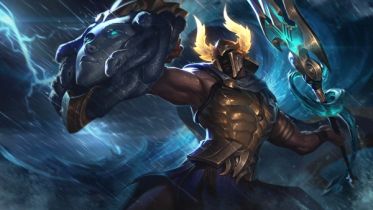Quick Gameplay Thoughts: 7/29
With the healing changes that were released in patch 12.14 we thought this would be a good opportunity to discuss healing in League. We’ve been seeing a lot of player feedback on the state of healing and Grievous Wounds recently, so we’d like to share how we’ve been thinking about these mechanics and how we’re looking to balance them moving forward.
Considerations around Healing Mechanics
Simply put, satisfying healing mechanics are typically frustrating for opponents to play against. Watching an opponent burst heal through your damage output and survive is typically a frustrating experience. There is also “sustained, burst healing” which allows champions to heal seemingly infinitely (eg. “Drain Tanking”). If a drain tanking champion gets ahead, there is little room for counterplay as they are neither “burstable” nor able to be killed in extended combat. It also reduces the quality of gameplay by creating a strong incentive to not fight. As a result, we tend to be very careful about designing champions and systems with “sustained, burst healing” as an output or ensure they have heavily exploitable counterplay opportunities for their opponents to capitalize on. E.g. Red Kayn is easier to kite, has worse target access compared to other members of his class and is reliant on landing his spells to heal.
Healing in League can also be snowbally. Healing spells are often fairly ratio and level driven to ensure that they remain at a satisfying value throughout the game. Secondly, healing can also take the form of Lifesteal or Omnivamp, which directly scales with how ahead you are. Combined, these effects can result in champions that are ahead feeling “unkillable”, due to their healing outpacing your damage.
While healing can present many challenges, we still think it’s a valuable and satisfying mechanic in League and it’s a core expectation for certain champions and subclasses. Let’s look at what good versions of healing gameplay look like.
Healing Gameplay
We tend to separate healing into two primary categories. The first category is for champions that have a majority of their power in healing and it’s tied to their gameplay identity (Aatrox, Soraka, Dr. Mundo, Red Kayn, etc.), these are “Core Healers”. The second category is where healing is included in a champion’s kit, but is not a primary source of power (e.g. Nami, Ahri, Irelia, etc.), who we’ll refer to as “Incidental Healers”.
Even if a champion is meant to heal a lot, how much is too much? On Patch 12.13, some of these champions in the first category were healing so much that their intended counterplay doesn’t work, even if their winrate is balanced. Let’s look at Aatrox as an example of this.
You’re kiting out Aatrox, he’s missing half his spells, and then he activates Goredrinker with his Passive and gets back to full health immediately. This probably feels off to most players. Aatrox is an example of a champion that has their gameplay identity directly tied to being a “Core Healer”. This is generally fine, but when they are still able to do it without being ahead, then something is off. This would spur us to align Aatrox’s healing more closely with his intended counterplay (e.g. more baseline durability, but less healing, so when he continuously misses, he’s more likely to die)
For incidental healers, when healing is a higher portion of the power budget than intended to create healthy gameplay for the kit, gameplay can begin to suffer. Let’s look at Irelia as an example. She's intended to be a low/moderate healer (from her Q and itemization) and therefore should have a moderate reliance on her W to mitigate damage. However, when she no longer needs to use her W skillfully and can facetank and heal through her opponent's damage, then that is an example of healing deteriorating gameplay. In these cases, we think healing has gone too far.
What makes balancing these cases tricky is that “acceptable healing” for healthy gameplay varies based on who you’re asking. Ultimately, the design team will use a combination of their assessment of what makes healthy gameplay and community perception of fairness to make this adjudication.
Grievous Wounds
In the same way that buying a Chain Vest against Zed does not guarantee that you will survive against his burst, you should not expect buying Grievous Wounds to mean that you win against these champions, especially if they get ahead. Grievous Wounds was not designed to be purchased against only one heavy healer. Instead, we expect that in the majority of cases, these champions should succeed and fail based on their inherent kit counterplay. E.g. finding flanks is intended to be easy against Soraka with her delayed hard CC and low 325 base Move Speed.
However, similar to buying Armor against a full AD comp, for every heavy healer on the enemy team, Grievous Wounds becomes more valuable. We intend to balance Grievous Wounds to be optimal when the enemy team has more than 2 heavy healers doing moderately well. Given the complexities of item based decision making, this calculus may change in game (e.g. if the healing composition scales, it may be better to just optimize for burst and try to end the game fast), but should be a good general rule to start with.
Grievous Wounds exists as an outlet to prevent healing stacking being an uncounterable strategy. While we would prefer players didn’t have to opt into Grievous Wounds items over other, more exciting options, it’s a necessary mechanic to prevent a team of 5 healers resulting in a degeneration of League’s gameplay.
Future State
Starting with Patch 12.14, we’re taking down some of these outlier healing cases and will continue to adjust healing to be more in line with designer and player expectations. As always, thanks for playing with us and see you on the Rift!










